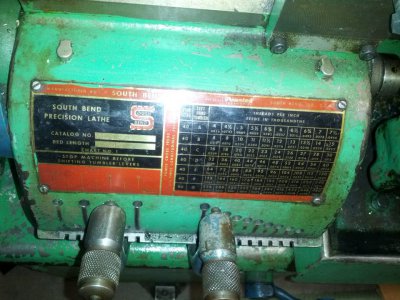Hi David,
@davidpbest
Thanks David, but I don't think I was clear, the z axis motion that is referred to in the spread sheet you attached is using the split nut lever which engages the lead screw (see descriptions: "Thread to thread in" and "Thread to thread mm"). These are simply the 1/TPI values. These values are not from the power feed lever which I think produces a much slower motion of the apron. The "power feed" lever moves the apron from the slotted rod not the lead screw. The apron gears for this power feed lever are different and so the feed rate is usually much smaller. It is on the PM1440GT.
If you look at the lathe Thread Chart plate, also shown in Figure 3-7 of the PM online PM1340GT manual you will see in the center of it a column that lists as power feed rates for the apron as well as for the cross slide (inches). They are not written out with any accuracy. Just compare them to the cross feed rates as well as to simple factors of 2s. Hence, I am trying to find a more accurate number. They do not depend upon your gear selection lever on the right (1,2,3, ...8) but do depend upon the left gear selector lever (A, B, C, D, E) so increments in factors of 2x only. In side the gear box, the gears associated with the A, B, C, etc selection drives the shaft that and gears that link to and turns the slotted rod. The transfer gears that are on this rod connect to another set of gears on a shaft that is above this one and which is connected to the lead screw ... for threading.
On my 1440GT the gear selection levers has an extra position called "I". It moves the lead screw gears to a position which is disengaged from the transfer gears on the slotted rods shaft. So when in the "I" position the lead screw does not turn but the slotted rod does and one can do Power Feed without turning the lead screw. I am not for sure why this feature is different between the lathes or why the 1440 needs to work this way but it maybe to allow one to do feeding without wear on the lead screw, split nut nor the lead screw and power feed gears, but even though your lead screw always turns you do not have to engage the spit nut to feed! So you can avoid wear on your split nut and leadscrew by just not using them for feeding. The lever setup on your 1340 is more like my old South Bend 10 (attached photo) which does not have a slotted Power Feed rod at all, but has a lot more threading options than the 1340GT. The SB10 has 10 fundamental threads with its lever selections and then there are 7 factors of 2. While the PM1440GT, with its two levers systems, is set up considerably different from the 1340 it has 16 fundamental gear selections. However, a number of them are not the standard threads and there is even a duplication of the 4TPI value, but worst thing is it is missing the 6TPI which means it is missing the standard 12TPI without using the external gears. The first set are: 4.200, 5.600, 7.000, 4.582, 3.000, 4.000, 5.000, 3.273, 2.400, 3.200, 4.000, 2.618, 4.125, 5.500, 6.875, 4.500.
With 7 factors of 2 and 10 fundamental threads the SB actually has the best set up for standard threads. It even has a position for 480TPI! I have yet to see anyone make such a thread, but it is very slow feed rate.
Thanks again.
Dave L.


